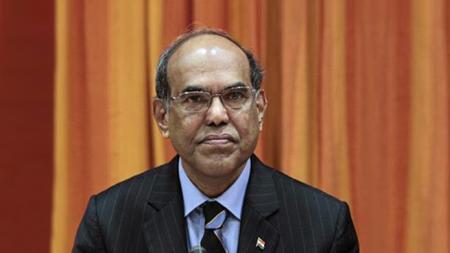Photographs: Reuters Business Standard in New Delhi
The Reserve Bank of India, in its review of monetary policy for the second quarter of the financial year 2012-13, has resisted calls to cut the policy rate. Instead, it has reduced the cash reserve ratio (CRR) of banks by 0.25 percentage point to 4.25 per cent of their net demand and time liabilities.
The action taken as a result of this review is, thus, the same as was taken in mid-September, when the policy rate was held constant but the CRR was cut marginally.
Both cuts were supposed to inject over Rs 17,000 crore (Rs 170 billion) of primary liquidity into the system. However, the degree to which this will help banks ease their lending rates and practices remains doubtful.
On one count, the RBI's action, whatever its merits, can be wholeheartedly welcomed: it demonstrates the continuing independence of India's monetary authority.
The central bank has been subjected to considerable pressure recently to cut rates, especially from the central government. The finance ministry has made no secret of the fact that it considers "co-ordination" between the fiscal and monetary authorities a virtue.
...
How long can RBI maintain status quo on policy rates?
Photographs: Danish Siddiqui/Reuters
The ministry has suggested to the RBI that it take "calibrated risks" while working "in tandem" with the government to shore up growth. It is essential for institutional stability that the RBI take decisions on its own, without paying undue attention to what the government in New Delhi would like. To that extent, the RBI's action deserves approval.
Clearly, RBI Governor D Subbarao does not yet think that the Centre's moves towards fiscal consolidation have gone far enough. He is right; they haven't.
The finance minister's road map for the next five years, suggesting a phased reduction of the fiscal deficit, makes for hopeful reading - but not much else, in the absence of credible action to control the government's subsidy bill.
The Centre cannot expect the RBI to step in automatically to flood the system with cheap credit, restart manufacturing growth and, in effect, clean up its mess; that evasion of responsibility is precisely what the independence of the monetary authority is supposed to avoid.
...
How long can RBI maintain status quo on policy rates?
Photographs: Reuters
The government must move forward on reform, unleashing animal spirits, and reducing the subsidy bill without hoping for a deus ex machina in the person of the RBI governor.
However, serious questions remain about India's stalling growth. Mildly more buoyant corporate results cannot take away from the fact that the investment pipeline has dried up.
As several recent reports have pointed out, capital expenditure sanctioned by the banking system fell off shortly from Rs 5.6 lakh crore (Rs 5.6 trillion) in 2003-04 to just Rs 50,000 crore (Rs 500 billion) in 2011-12. There are no signs of revival here.
The RBI cannot continue to ignore that it must kick-start lending by the banking system. While inflationary pressures continue on consumer prices thanks to food and fuel, the RBI's review puzzlingly overstates the amount of "core" inflation, which is around 5.6 per cent year-on-year, down from its peak of 8.5 per cent last year. This is not a figure or trajectory associated with runaway expectations.
True, the RBI has effectively stated in its guidance that a rate cut will happen before the end of this financial year. But judging by the fall-off in capital expenditure, the central bank will have to take a call on whether the end of the year will be too far away.





article